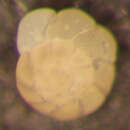mk
имиња во трошки


Ammonia tepida és un foraminífer bentònic omnivor[2]
Com altres foraminífers que viuen en els sediments utilitzen els seus peudòpodes per a recollir els sediments que contenen algues, detritus orgànics i bacteris. En el cas d’aquesta espècie Ammonia tepida, s’ha estudiat i quantificat la captura de bacteris. En condicions mitjanes, A. tepida recull 78 pgC ind-1 h-1 durant les primeres 8 hores d’incubació i després aquesta taxa disminueix. La captura de bacteris és òptima a 30°C, disminueix amb la salinitat i no està afectada per la llum ni per l’abundància d’algues, malgrat que Ammonia sembla que depèn principalment de les algues[3]
Ruiz, Francisco; Gonzalez-Regalado, Maria Luz; Abad, Manuel; Munoz, Juan Manuel; Pino, Rafael «New applications of the Poisson distribution in micropalaeontology: relationships between environmental variables and the Ammonia tepida distribution in the south-western Spanish estuaries». Terra Nova, 19, 5, octubre 2007, pàg. 372. DOI: 10.1111/j.1365-3121.2007.00761.x [Consulta: 12 febrer 2015].
Ammonia tepida és un foraminífer bentònic omnivor
Com altres foraminífers que viuen en els sediments utilitzen els seus peudòpodes per a recollir els sediments que contenen algues, detritus orgànics i bacteris. En el cas d’aquesta espècie Ammonia tepida, s’ha estudiat i quantificat la captura de bacteris. En condicions mitjanes, A. tepida recull 78 pgC ind-1 h-1 durant les primeres 8 hores d’incubació i després aquesta taxa disminueix. La captura de bacteris és òptima a 30°C, disminueix amb la salinitat i no està afectada per la llum ni per l’abundància d’algues, malgrat que Ammonia sembla que depèn principalment de les algues
Ammonia tepida is a benthic foraminifer living in the sediment of brackish waters. It is very similar to Ammonia beccarii, but the latter lives on the surface of red algae.[2] Once considered a globally widespread taxon, a recent genetic and morphological study has revealed that many of what were once considered members of A. tepida in fact represent other species of Ammonia, primarily Ammonia veneta, with true specimens of A. tepida only being found in Atlantic waters, off the coast of the Americas.[3]
Ammonia tepida is found in the sediment of brackish waters. It is able to tolerate a wide range of temperatures and degrees of salinity, as well as to survive severe environmental conditions. As it is easy to keep in the laboratory, being able to reproduce both asexually and sexually without problem, it considered an ideal organism for laboratory studies.[4]
The diet of A. tepida consists mainly of other microorganisms. Algae form about 80–90% of its diet and the remaining is composed by bacteria.[5] Laboratory experiments showed that it may also prey on small animals, such as nematodes, copepods and mollusk larvae.[6]
Ammonia tepida is a benthic foraminifer living in the sediment of brackish waters. It is very similar to Ammonia beccarii, but the latter lives on the surface of red algae. Once considered a globally widespread taxon, a recent genetic and morphological study has revealed that many of what were once considered members of A. tepida in fact represent other species of Ammonia, primarily Ammonia veneta, with true specimens of A. tepida only being found in Atlantic waters, off the coast of the Americas.